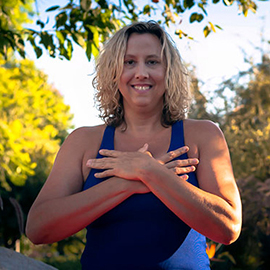What to do about tight Psoas Muscles in Seniors
After my class yesterday, I was told that we should not be doing any knee lifts in class because most of the seniors hip flexors are tight to begin with and that we need to do more stretching of the hip flexors and the Psoas muscle in particular.
For the seniors that do sit a lot and have tight hip flexors that doesn’t mean that their hip flexors are strong. What would be the best way to answer this person that approached me? I could not finish the conversation with her because I had to teach another class but I do want to get back to her. On a side note, she is a long time retired Physical Therapist!

Psoas Exercises for Seniors
I understand what the woman is saying….but as Yoga Therapists, we try to never be be dogmatic in our approach. So, anytime someone says ‘always’ or ‘never’ – a red flag goes off for me!
The Best Way to Stretch the Psoas Muscle
You are SO right, just because the hip flexors are tight does NOT mean they are strong. They are chronically contracted and most likely weak. It is important to strengthen them. In order to stretch the Psoas muscle, they need to be contracted first. Doing multiple knee lifts will not only strengthen them, but prepare them to be stretched in a safe way by activating PNF (proprioceptive neuromuscular facilitation).
When a muscle is contracted, it signals the brain to recognize the muscle position and condition. Then, when the muscle is stretched with Yoga sequences similar to the ones below, it makes the Psoas muscle agreeable to a lasting stretch or elongation of the tissue – not only muscular tissue but the fascia as well. The brain always likes contrast so it can find equilibrium.
Yoga Poses to Release a Tight Psoas Muscle
Taking a tight muscle and just stretching it will cause it to resist the stretch…..and can be a risk for injury. Better to engage it and shorten in several times before going for a stretch. Later in the class a standing Warrior One will stretch the psoas of the back leg, and the stretch will be enhanced if the arm on the side of the back leg is raised – it will lift the origin of the muscle, and deepening the breath will further enhance it by increasing the movement of the diaphragm, of which the central tendon is the origin of the psoas muscles. IF the pose can be sustained for up to two minutes, all the better as it takes the connective tissue/fascia that long to truly stretch.
Stretching the quads is also important as they are hip flexors as well. But strengthening the quads is equally if not more important than strengthening the psoas (quads are the ‘muscles of independence’ as Sherry says!) Those can be strengthened with knee extensions from a seated position, followed by a seated or standing quad stretch.
Special Consideration for Seniors
I wanted to add in a little more food for thought……with seniors we also have to be aware of bone health. We want to get circulation into the muscles and keep them limber and ‘juicy’ so to speak. If the tissue is atrophied or dried out, and we try to force a stretch that can have a negative impact on the bones (think fracture or break). If the ligaments/muscles/connective tissues are dried out and brittle, that can be risky for even spontaneous fractures. That is why moving is so essential, and repeating those poses, and movements in all directions (safely!) is so important….to keep everything nourished! I hope this helps. ![]()
In your student’s defense, I am not sure how long she has been retired, but a lot of theory and research in regards to how the body works, in particular the fascia, has been done in the last decade. She might not be up on the latest research. She seems to be coming from a place of wanting to help. I hope this gives you some good talking points! Please feel free to reach out if I wasn’t clear in my description.
Namaste,
Justine Shelton, Certified Yoga Therapist
Low Back Pain & Sciatica: The Role of the Piriformis & Psoas Muscles with Justine Shelton, C-IAYT
Much of low back pain is caused by tight muscles that bind and constrict movement, as well as nerves that can be pinched because of muscle tension. Certified Viniyoga Therapist, Justine Shelton, describes the function of the Psoas and Piriformis muscles, why they can contribute to low back pain … and most importantly she shares what gentle yoga movements can help stretch and release these muscles.
Hip Flexor Trio Stretch: A Great Way to Improve your Gait with Sherry Zak Morris, C-IAYT
Our hip flexors are our gait muscles. They help propel us forward with every step we take. The tighter these muscles, the shorter our walking gait can become. That can lead to tentative movements and more trips and falls. Many of the hip muscles are responsible for more than one type of movement in the hip, as different areas of the muscle act on tendons in different ways. When we do specific Yoga poses and sequences, we are targeting specific muscle groupings for a particular purpose.
Find out why the iliopsoas muscles (aka hip flexors) muscles are important for keeping you walking tall and with confidence! Enjoy these few stretches that will help keep them strong, lengthened and healthy.
Hip Glide in a Chair – For a tight Quadratus Lumborum & Psoas Muscles with Sherry Zak Morris, C-IAYT
Feeling scrunched up, tight around the ribs, waist and hips? This is what happens when we sit too long or stand crooked, gravity scrunches us! There are two main muscles that get weak and contracted when we sit for long periods of time. They are the Quadratus lumborum and the Psoas muscles. When tight and weak, they can affect your gait and balance.
Try this great hip and side body movement created by Soma-Kinetic Expert, Erhard Rohrmuller, but modified using a chair so everyone can benefit.

Justine Shelton, Certified Yoga Therapist & Co-Founder of the Yoga Vista Academy
Justine is a graduate of the American Viniyoga Institute under the direction of Gary Kraftsow. She is the Co-Founder of the Yoga Vista Academy and author of their ‘Gentle Yoga for Low Back Care specialty certification program. Justine specializes in structural yoga therapy, specifically spinal disc injuries, back pain management, as well as joint therapy – including prehab and rehab for replacements.

Sherry Zak Morris, Certified Yoga Therapist and Co-Founder of the Yoga Vista Academy
Sherry is a Certified Yoga Therapist and has a proven track record for empowering and igniting passion for 50+ Yoga and wellness. A 3-Time Presenter at the annual Yoga Alliance Conference, the professional and trade association of the yoga world, her enthusiasm for serving those with movement limitations gained exposure for her Specialty Teacher Training Programs. Sherry’s work can be found on YouTube and in the Yoga Vista Online Video Library, YogaVista.TV, where she shares her special style of Energizing Yoga that is accessible to everyone!

